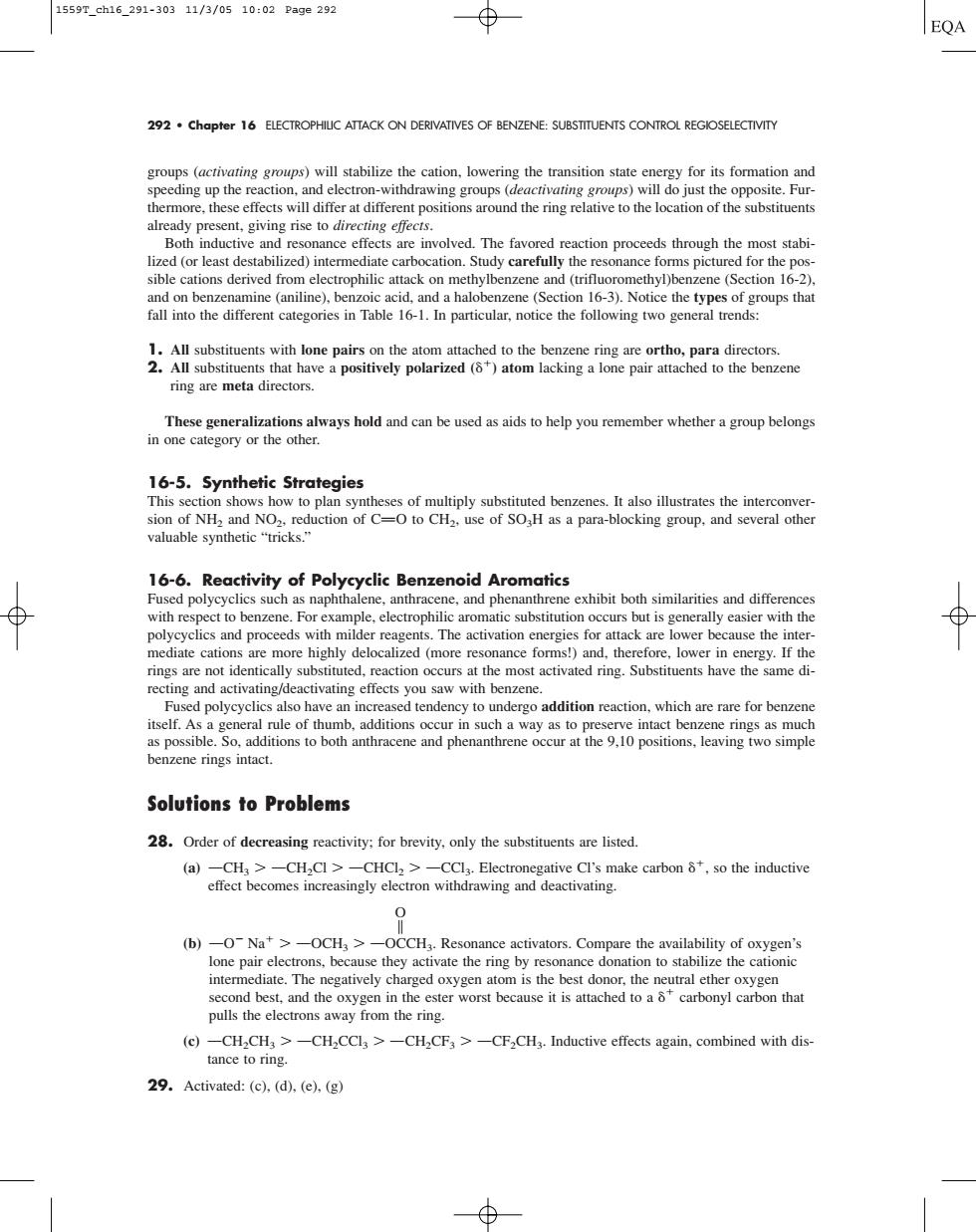正在加载图片...

1559T_ch16_291-30311/3/0510:02Page292 ⊕ EQA 292 Chapter 16 ELECTROPHIUC ATTACK ON DERIVATIVES OF BENZENE:SUBSTITUENTS CONTROL REGIOSELECTIVITY s)will stabilize the cation.lowerine the transition stat for its formation an and electron-withdrawing groups(d nore,thes Both inductive and resonance effects are involved.The favored reaction proceeds through the most stabi lizedorleastd lized)intermediate carbocation.Study carefully the resonand ce foms pictured for the po fall in theifler cae in Table 1-1.paicc the one s that 1.All substituents with lone pairs on the atom attached to the be 2.Al substitucnts that havepositively porized(atom lackinga lon pair attached tothe ben ring are meta directors. These generalizations always hold and can be used as aids to help you remember whether a group belongs in one category or the other. 16-5.Synthetic Strategies This on as a para 16-6.Reactivity of Polycyclic Ben id Ar Fused polycyclics such as naphthalene,antracene,and phennthrene exhibit both similarities and difference .Ir the rings are not identically substituted.reaction occurs at the most activated ring.Substituents have the same di- which rule of thumb.additions occ in such a way as to p in benzene rings as muc eSoddiions to both nhace and phenantenet thpositionsleavingwo simple Solutions to Problems 28.Order of decreasing reactivity:for brevity,only the substituents are listed (a) ingly e (b)-O-Na+>-OCH,>-OCCH3.Resonance activators.Compare the availability of oxygen's on they activate therin onation to stabili e the cationic second best.and the oxygen in the ester orst because it is attached to acarbonyl cabon that pulls the electrons away from the ring. (e)-CH2CHa>-CH.CCla>-CH2CF3>-CF2CH3.Inductive effects again.combined with dis tance to ring. 29.Activated:(c),(d).(e).(g) 292 • Chapter 16 ELECTROPHILIC ATTACK ON DERIVATIVES OF BENZENE: SUBSTITUENTS CONTROL REGIOSELECTIVITY groups (activating groups) will stabilize the cation, lowering the transition state energy for its formation and speeding up the reaction, and electron-withdrawing groups (deactivating groups) will do just the opposite. Furthermore, these effects will differ at different positions around the ring relative to the location of the substituents already present, giving rise to directing effects. Both inductive and resonance effects are involved. The favored reaction proceeds through the most stabilized (or least destabilized) intermediate carbocation. Study carefully the resonance forms pictured for the possible cations derived from electrophilic attack on methylbenzene and (trifluoromethyl)benzene (Section 16-2), and on benzenamine (aniline), benzoic acid, and a halobenzene (Section 16-3). Notice the types of groups that fall into the different categories in Table 16-1. In particular, notice the following two general trends: 1. All substituents with lone pairs on the atom attached to the benzene ring are ortho, para directors. 2. All substituents that have a positively polarized () atom lacking a lone pair attached to the benzene ring are meta directors. These generalizations always hold and can be used as aids to help you remember whether a group belongs in one category or the other. 16-5. Synthetic Strategies This section shows how to plan syntheses of multiply substituted benzenes. It also illustrates the interconversion of NH2 and NO2, reduction of CPO to CH2, use of SO3H as a para-blocking group, and several other valuable synthetic “tricks.” 16-6. Reactivity of Polycyclic Benzenoid Aromatics Fused polycyclics such as naphthalene, anthracene, and phenanthrene exhibit both similarities and differences with respect to benzene. For example, electrophilic aromatic substitution occurs but is generally easier with the polycyclics and proceeds with milder reagents. The activation energies for attack are lower because the intermediate cations are more highly delocalized (more resonance forms!) and, therefore, lower in energy. If the rings are not identically substituted, reaction occurs at the most activated ring. Substituents have the same directing and activating/deactivating effects you saw with benzene. Fused polycyclics also have an increased tendency to undergo addition reaction, which are rare for benzene itself. As a general rule of thumb, additions occur in such a way as to preserve intact benzene rings as much as possible. So, additions to both anthracene and phenanthrene occur at the 9,10 positions, leaving two simple benzene rings intact. Solutions to Problems 28. Order of decreasing reactivity; for brevity, only the substituents are listed. (a) OCH3 OCH2Cl OCHCl2 OCCl3. Electronegative Cl’s make carbon , so the inductive effect becomes increasingly electron withdrawing and deactivating. O B (b) OO Na OOCH3 OOCCH3. Resonance activators. Compare the availability of oxygen’s lone pair electrons, because they activate the ring by resonance donation to stabilize the cationic intermediate. The negatively charged oxygen atom is the best donor, the neutral ether oxygen second best, and the oxygen in the ester worst because it is attached to a carbonyl carbon that pulls the electrons away from the ring. (c) OCH2CH3 OCH2CCl3 OCH2CF3 OCF2CH3. Inductive effects again, combined with distance to ring. 29. Activated: (c), (d), (e), (g) 1559T_ch16_291-303 11/3/05 10:02 Page 292������������